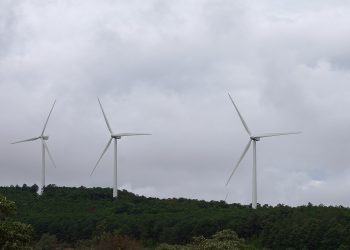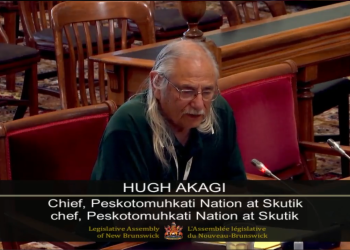Energy storage plays a key role in helping wind and solar power dominate the growth in electrical grid capacity. Storage includes batteries or other systems that hold energy until it’s needed. With adequate storage, the New Brunswick electrical grid no longer needs energy sources such as natural gas that emits greenhouse gases (GHGs) or risky and expensive nuclear power.
All energy comes at some cost to the environment, so it is important not only to pick renewable sources which have the least impact but also to be efficient and effective with energy use. The Coalition for Responsible Energy Development in New Brunswick (CRED-NB) stands in solidarity with communities experiencing the impacts of our energy choices. CRED-NB also acknowledges that while transitioning to renewable energy sources will greatly reduce the volume of mining, that activity must be carried out with the most environmentally and socially conscious methods possible.
Thankfully, minerals extracted for use in building renewable energy sources and energy storage can mostly be reused or recycled, or both, since the “fuels” are only wind, water, and sunshine. In contrast, materials coming into contact with a nuclear reactor become radioactive and cannot be recycled.
Balancing an electrical grid
At each moment of a day, an electrical grid requires a match between the total amount of power requested by customers (aka “the load”) and the total power being supplied. The load swings up and down; for example, the load is pushed up when customers switch on their electrical appliances and pushed down when electrical appliances are turned off. The power supplied by the grid must increase and decrease to match the load and keep the grid balanced.
A baseboard room heater can cause a load of 1,000 watts (1 kW) or more when in use. A whole household in New Brunswick may cause a load of up to 40 kW or more depending on the electrical devices in use. With all the households, businesses and industry combined, the total load on the grid runs from a million kW (one gigawatt or 1 GW) up to over 3 GW. The total load on the New Brunswick grid reached an all time high when it peaked at 3.4 GW briefly during a cold morning in February 2023.
To balance that load, NB Power owns a total of over 5 GW of power supplies. That includes about 4 GW of power generators. The big ones are the Mactaquac dam, the Lepreau nuclear plant, and the Belledune coal plant. NB Power can also buy or sell electricity to and from neighbours, with 1 GW of transmission capability from Quebec and some transmission capability with Nova Scotia, PEI and Maine.
Adding renewables to an electrical grid
To reduce both greenhouse gas emissions and costs, many countries are switching to wind and solar power, now the least expensive sources of electricity. There is excellent potential for using wind and solar power in New Brunswick to reduce costs and carbon emissions. Unfortunately, so far NB Power has only installed one small solar array and owns no wind turbines at all, although it does buy power from a few privately owned wind farms.
Wind and solar change their power output based on the weather and time of day. Currently in New Brunswick, the small amount of power from wind and solar can be balanced by simply adjusting the output from other power supplies. Spreading out the locations of the wind farms and solar farms reduces the net variations making the total power output more consistent. In fact, doing this cooperatively across provincial borders would improve the effectiveness of wind and solar resources across the Maritimes and Quebec.
One of the most effective and economical ways to balance large amounts of wind and solar power is energy storage. Many storage options exist now and many more are on their way.
Note that hydroelectric power and geothermal power (heat from the earth) are also excellent sources of renewable energy. They are more expensive but can provide power on demand so nicely complement the variable nature of wind and solar. Although we are unlikely to build more hydroelectric dams in New Brunswick, NB Power is projecting a 5% increase in power at the Mactaquac Dam after the upcoming refurbishment. We also have significant geothermal potential which should be explored promptly as geothermal power can take years to develop.
Grid scale storage
When the sun is shining or the wind is blowing, wind and solar farms can produce more power than needed on an electrical grid. When that happens, if no other jurisdiction needs that power, then the power is discarded or “curtailed”. If the amount of curtailment becomes significant, it makes sense to install storage. Storage saves that extra energy for later use rather than discarding it. Luckily, there are lots of grid scale energy storage options.

The most commonly used grid storage in the world is pumped hydro storage (PHS), although Canada currently has only one PHS, in Ontario. PHS is different from a hydroelectric power plant in that PHS stores energy produced elsewhere while a hydroelectric power plant is a source of energy. A PHS site has two water reservoirs: one up a hill and the other at the bottom, with the water pumped to the top when excess power is available on the grid and released through a turbine when power is needed. PHS is very affordable and efficient but it can only be located where the geography is suitable and must be fairly large to be economic. New Brunswick does have several geographically suitable sites which should be considered for PHS.
The lithium-ion battery has garnered lots of both attention and grid-scale installations world-wide since 2017. The cost of these versatile batteries has dropped so much that they now dominate the grid-scale storage market globally. They are very efficient, can be placed almost anywhere, can start with a small installation which can be increased in capacity over time and take very little space.
PHS and lithium-ion batteries can do an excellent job of handling lulls in wind and solar power during most days but sometimes the dips in output last much longer. Long-duration storage solutions are able to hold larger amounts of energy yet are economical even when not used often. They can discharge at full power for durations of about ten or more hours. As the number of wind & solar installations have grown so has the number of types of long-duration storage solutions.
One example of long-duration storage is the iron-air battery. Iron-air batteries provide a duration of up to 100 hours or four days. They are far less expensive than lithium-ion batteries but are not suitable for shorter time periods because they are only about half as efficient. The impact of having less efficiency is not as significant for long-duration storage since an electrical grid needs to draw power from it far less often.
What happens if the wind doesn’t blow and the sun doesn’t shine for weeks? Not likely, but it could happen, and utilities need to have reserves on hand for a variety of other reasons as well. This is especially important when considering the huge difference in the amount of energy and power needed during the summer vs the winter months in New Brunswick. This is where inter-seasonal storage comes in.
More electricity is consumed during the winter in New Brunswick to heat homes and commercial buildings to comfortable temperatures. The most cost-effective manner to store energy for winter heating is to store heat, i.e. thermal storage. One way to store heat is to use boreholes drilled in the earth. Boreholes have been shown to be very cost-effective in storing the ample free heat available in the summer for use in heating during the winter. A district heating arrangement – where heat is supplied to multiple buildings – is the most effective use of boreholes. One recent example is the George Street campus of the University of Toronto which has drilled 372 boreholes under the parkade to store the heat removed from buildings during the summer.
Inter-seasonal storage of clean energy can also be achieved by producing green hydrogen using the extra energy produced from renewables at various times especially during the warmer months. Hydrogen can be pulled out of storage to generate emissions-free electricity as needed. It can be safely and inexpensively stored in salt caverns for seasons or even years. The large amounts of salt deposits in New Brunswick make this approach quite practical. Although green hydrogen is expensive to produce, this technique can provide a cost-effective capacity reserve.
As global research and investment grows into wind and solar power, their already low cost is projected to continue to fall. A similar trend for storage products will result in many improvements in cost and effectiveness coming to market well before the end of this decade. New Brunswick has excellent renewable energy resources which would be the foundation of a clean affordable electricity grid. It is time for New Brunswick to start building a clean affordable electricity grid with renewable energy and storage.
Tom McLean is with the Coalition for Responsible Energy Development in New Brunswick.







![Advocates reveal details about ‘systematic exploitation’ at New Brunswick seafood processor [video]](https://nbmediacoop.org/wp-content/uploads/2025/10/Bolero-120x86.jpg)


